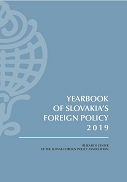Slovak Security and Defense Policy in 2019
Slovak Security and Defense Policy in 2019
Author(s): Dušan Fischer
Subject(s): Politics, International relations/trade, Security and defense, Military policy
Published by: Research Center of the Slovak Foreign Policy Association (RC SFPA)
Keywords: Slovakia; NATO; security; defense policy; 2019; EU; foreign policy;
Summary/Abstract: When 2019 started, there were several defense and security issues to be resolved. The EU was preparing for its parliamentary election and Brexit day was still in the pipeline. It had been almost three years since the referendum, so desperation on both sides had turned into a tiresome wait for the United Kingdom to finally leave the EU. There were a couple of related questions, such as what kind of relationship would the EU and UK agree in relation to Common Foreign and Security Policy (CFSP). In addition, with the United Kingdom leaving the EU, the member states felt the urge to address third party participation in Permanent Structure Cooperation (PESCO). In NATO the leadership and members were starting to get along with the U.S. administration and were able to distinguish words from actions. After reassurance from some U.S. government representatives, although not its head, NATO continued going forward, expanding rapid deployment, securing the Eastern and Southern Flanks by military and non-military means and keeping the door open for possible accessions. The Eastern Flank of Europe, particularly the ongoing frozen conflict in Ukraine led Slovakia to follow NATO’s policy of improving readiness through military exercises and by building security capacities, such as the NATO Force Integration Unit.
Book: Yearbook of Slovakia's Foreign Policy 2019
- Page Range: 47-59
- Page Count: 13
- Publication Year: 2019
- Language: English
- Content File-PDF

